![]()
WebKey: DESMIDS
Phylum Chlorophyta; sub-phylum Chlorophyceae; Order Zygnematales
There are two groups of Desmids: the "Placoderm" and the "Saccoderm" Desmids.
Placoderm desmids have cells composed of two halves (semicells), often almost divided from each other by deep median incisions. The cells are symmetrical about 3 planes, and often bear elaborate ornamentation. Genera are Cosmarium, Cosmocladium, Euastrum, Micrasterias, Staurastrum, Staurodesmus, Xanthidium.Saccoderm desmids are simple shapes, cylindrical or spindle-shaped, rarely with any median constriction. This group forms the family Mesotaeniaceae and includes the genera Cylindrocystis, Mesotaenium, Netrium, Roya, Spirotaenia, Tortitaenia, and, in the suborder Closteriinae, Closterium, Gonatozygon and Penium, and in the suborder Desmidiinae, Actinotaenium.
KEY to Genera:
Go to: |
|||
| 1a | Cells solitary, symmetrical |
 |
2 |
1b |
Cells in colonies or linked together in filaments |
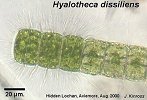
 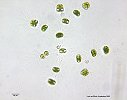 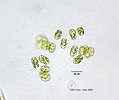 |
15 |
| 2a | Cells more or less cylindrical |
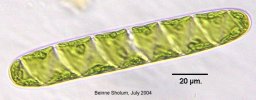 |
3 |
| 2b | Cells a more complex shape |
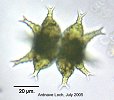 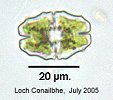 |
9 |
| 3a | Cells with a median constriction |
 |
4 |
| 3b | Cells without a median constriction |
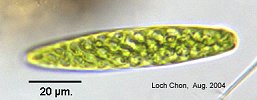 |
6 |
| 4a | Median constriction slight |
||
| 4b | Median constriction conspicuous |
 |
5 |
| 5a | Apex without a median notch |
  Pleurotaenium Pleurotaenium |
|
| 5b | Apex with a median notch |
Tetmemorus (no illustration available) | |
| 6a | Chloroplasts 2 simple ribbons |
 Gonatozygon Gonatozygon |
|
| 6b | Chloroplasts 2, stellate or ridged |
7 | |
| 7a | Walls smooth, without pores |
8 | |
| 7b | Walls with pores / granulation / striation |
||
| 8a | Choloroplasts stellate |
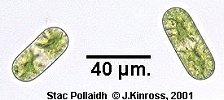 Cylindrocystis Cylindrocystis |
|
| 8b | Chloroplast ridged with notched edges |
 Netrium Netrium |
|
| 9a | Cells flattened from front to rear, with distinct median isthmus |
 (side view) (side view)  (frontal view) (frontal view) |
10 |
| 9b | Cells radially symmetrical, with distinct median isthmus |
 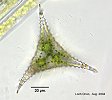 (end-on view) (end-on view) 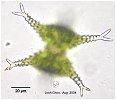 (Frontal view) (Frontal view) |
14 |
| 10a | Lateral margins not incised |
 |
11 |
| 10b | Lateral margins slightly incised; apex with a deep notch or slightly depressed |
   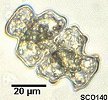 Euastrum Euastrum |
|
| 10c | Lateral margins deeply incised | 
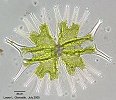 Micrasterias Micrasterias |
|
| 11a | With marginal spines |
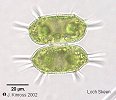
 |
12 |
| 11b | Without marginal spines |

 |
13 |
| 12a | Cell face has a central protuberance |
 Xanthidium Xanthidium |
|
| 12b | No central protuberance |
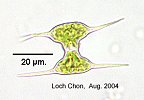 Staurodesmus Staurodesmus |
|
| 13a | Angles of semicells extended into processes |

  Staurastrum Staurastrum |
|
| 13b | Angles of semicells not extended into processes |
 Cosmarium Cosmarium |
|
| 14a | With spines at angles |
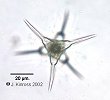
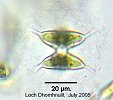 Staurodesmus Staurodesmus |
|
| 14b | Angles of semicells extended into processes |
 Staurastrum Staurastrum |
|
| 15a | Colonies of Cosmarium-like cells connected by mucilage strands |
  Cosmocladium Cosmocladium |
|
| 15b | Cells linked together as filaments |
16 | |
| 16a | Cells linked by apical processes |
17 | |
| 16b | Cells not linked by apical processes |
18 | |
| 17a | linked by a single apical process |
 Sphaerozosma Sphaerozosma |
|
| 17b | linked by paired apical processes | Onychonema | |
| 18a | Cells flattened, not radially symmetrical in apical view | 19 | |
| 18b | Cells radially symmetrical in apical view: filament appearing to twist as cells are linked slightly offset from each other | 20 | |
| 19a | Cells divided by a deep median sinus, somewhat Cosmarium-like: linked together at the poles |
 |
21 |
| 19b | Cells rather barrel-shaped, without a median sinus. Filament in a mucilage sheath sometimes with a fibrillar structure clearly visible: single stellate chloroplast. |
 Hyalotheca Hyalotheca |
|
| 20a | Cell with a median notch |
 Desmidium Desmidium |
|
| 20b | Cells markedly barrel-shaped, with a shallow median sinus |
 Bambusina Bambusina |
|
| 21a | Cells linked by small apical granules |

  Teilingia Teilingia |
|
| 21b | Cells linked at flattened apices, no granules |
 Spondylosium planum Spondylosium planum |
|
| 22a | Cells short, cylindrical |
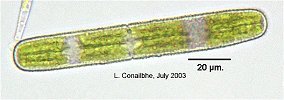 Penium Penium |
|
| 22b | Cells tapering, straight to strongly curved |

 Closterium Closterium |
|
This key owes much to the diagrammetic key in Desmids of the English Lake District, by EM Lind and AJ Brook, Freshwater Biological Association, Ambleside
John Kinross